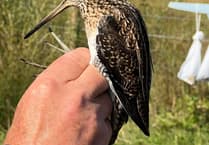It has been a hectic September for members of the Tice’s Meadow Bird Group (TMBG).
In addition to the usual management tasks members have led walks for both the Hartley Wintney U3A and twice for the public, the latter as part of Farnham Heritage days.
Members have also visited the Waverley Grange Care Home and provided marshals for the Farnham Weyside Rotary Pilgrims marathon.
There has also been the showing of the film Our Meadow at the Maltings which the Herald recently reported.
Work parties have continued clearing the river and removing invasive willow saplings from the reed beds. Without constant managing the willow would swamp the reedbeds, thus destroying a vital habitat. Thanks to the efforts of the volunteers the reed beds are thriving and the bird life flourishing.
Cetti’s Warbler – which was a rare visitor up until four years ago – is now an established breeding species at Tices and one particular Reed Warbler has been caught by the ringing team for seven successive summers. This proves it has migrated between the UK and Africa annually for that length of time.

The volunteers come from a variety of sources. I was at a work party on October 12 which included girls volunteering as part of the DofE scheme, residents from the neighbouring housing estate, TMBG members and customers of the Surrey Choices Growth team.
The latter’s supervisor Darryl Whitaker explained these young men had learning difficulties and working outdoors has proved to be hugely beneficial to them.
Several of them have progressed sufficiently to find long term employment opportunities. The next work party is on November 2 at 10.30am, so why not join us?
On the birding front, a few summer migrants, mainly Sand Martins, have hung on and the winter visitors are yet to arrive. The 2024 bird list has swollen to 132 with the addition of an Arctic Skua and Ruff.
-(1).png?trim=10,0,9,0&width=752&height=500&crop=752:500)
Arctic Skuas nest in northern areas with some breeding on the Scottish coast but have been in decline with bird flu accelerating their sad demise.
The bird at Tices was a juvenile on passage to the Atlantic, where hopefully it will winter off the coast of South Africa or Argentina before returning next spring.
Skuas are extremely strong, elegant and acrobatic flyers. They harry other sea birds so aggressively that the chased bird regurgitates its last meal which is frequently caught and swallowed by the pursuing skua, before it lands on the sea.
The Ruff, which was almost certainly on passage from its Scandinavian or Russian breeding grounds to North Africa also has an interesting behaviour. Usually a fairly nondescript waders, in the breeding season the males develop exaggerated feathers around their necks and heads and gather in favoured spots or leks where the females have gathered.
Here the males literally display their wares, puffing out their feathers and leaping high in the air. The females tend to look down their beaks at this behaviour but eventually make a selection from the preening males and mating occurs. By Alan Wynde




.jpg?width=209&height=140&crop=209:145,smart&quality=75)


Comments
This article has no comments yet. Be the first to leave a comment.